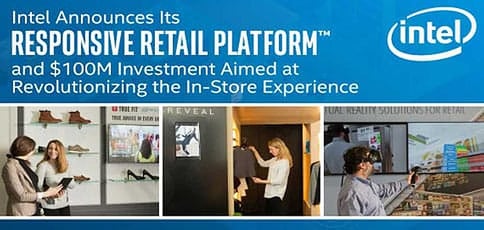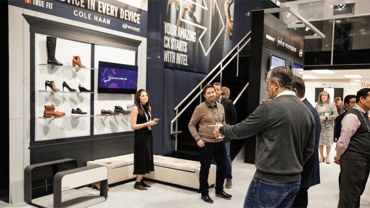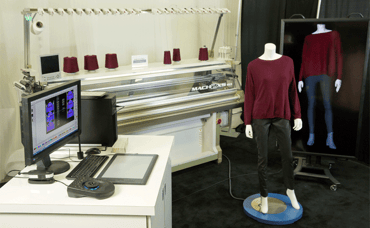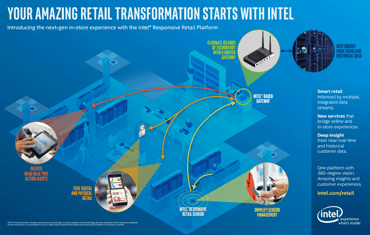
TL; DR: As the world’s leading chipmaker, Intel is in prime position to deliver on CEO Brian Krzanich’s $100 million pledge to transform the in-store shopping experience through connected technology. The Intel Responsive Retail Platform™ was on display during our visit to the National Retail Federation’s 2017 Big Show. Along each stop of our tour of Intel-powered partner solutions, actionable data was the common thread. Retailers have been hearing about the benefits of big data for years, and through Intel’s platform, they’ll be equipped with the technology to turn information into improved customer experience and employee efficiency.
One of the key announcements at the National Retail Federation’s 2017 Big Show came when Intel CEO Brian Krzanich took the stage in New York City to introduce his company’s Responsive Retail Platform (RRP), and announce his commitment to invest $100 million over the next five years in retail technology.
Designed to help brick-and-mortar storefronts catch up to the robust data analysis that’s already driving e-commerce sales, Intel RRP’s aim is to unify digital and physical commerce through connected Internet of Things (IoT) technology.
A big factor slowing progress is retailers still operating outdated, disparate systems at every point along the supply chain. Intel, known as the world’s most famous chipmaker, recognized the need for a common platform to enable all of the hardware, software, APIs, and sensors to work together, turning data into results.
The day after Intel’s big announcement, our team attended Intel’s media breakfast at the Big Show, where we had the opportunity to see some of this technology in action. Ryan Parker, General Manager of Responsive Retail for Intel, gave us a guided tour that demonstrated how Intel is helping its partners turn possibilities into realities in retail.
Ryan told us most retailers are already collecting customer information and are looking to make the next logical step: using information to deliver personalized experiences that positively impact the bottom line.
“We did an internal study, and we have quote after quote, saying, ‘Data is not my problem. I have way too much data. What do I do with it?’” Ryan said. “When we’re looking at companies to bring into our Responsive Retail Platform, we’re always looking at action. What we really want to understand is what can we do with this data that’s unique and different?”
We’ve boiled all of the partner solutions down into a highlight reel of some of the more exciting things we saw during our trip through the Intel booth, including products that improve customer experiences and keep employees informed.
New Innovations to Enhance Engagement & the Customer Experience
Data plays a key role in delivering personalized experiences, which was easy to see in action at several stops along the Intel tour.
One interesting partner solution was created in response to the disconnect between business and customer preferences. Americans prefer other forms of communication, such as text messages rather than phone calls, with millennials driving the trend. Built on Intel technology, Banter™ is a mobile application that allows businesses to connect with customers using conversational language over SMS, Facebook Messenger, Twitter, and other platforms.
The Banter team found that 80% of customer interactions can be handled by the application, and an algorithm is used to route the remaining 20% of customer questions to the right people. While 80% of questions handled seamlessly already frees up employees to do more, that number will continue to climb the more the app is used because it uses machine learning to improve results. Banter also serves as an assistant, helping customers find items in stores and arranging for product shipments by tapping into companies’ customer databases.
During the media breakfast, Intel also introduced a beta version of a 3D foot scanner, which integrates with True Fit™ to help consumers find the best-fitting pairs of shoes by leveraging the True Fit Genome, a product spec database that factors in thousands of footwear brands.

Intel’s 3D foot mapping integrates with the True Fit Genome to ensure customers find the shoes that fit them best.
“That combination is pretty powerful because it’s actually my foot,” Ryan said, pointing to his feet. “And with these 13 quadruple-Es, I can tell you shoes are not easy to find.”
True Fit currently analyzes apparel shopping data from hundreds of millions of anonymous shoppers to serve retailers, but around 30 million consumers have created user profiles to help them find the best-fitting shoes and apparel with that number growing at 1.5 million new users every month.
Another Intel partner doing its part to improve the customer experience is Telefonica™, which was showing off a solution it calls spotlabel™ that allows retailers to change pricing and promotions digitally so customers always see up-to-date information while shopping in stores, keeping customers engaged and informed when browsing.
Optimizing Operations & Manufacturing Through Connected Tech
While the partnerships Ryan showed us at the media breakfast demonstrated the value RRP presents for customers, the platform is also focused on helping companies improve efficiency in manufacturing and empowering employees through Intel technology.
One display within the Intel booth that stood out was a giant machine in the middle that was knitting a sweater using 3D printing technology. Shima Seiki™ is challenging the idea of the traditional supply chain with knitting machines that allow designers to create ideas, upload them, and bring them to life in a wide variety of textiles, stitches, and colors and get them on the shelves in only two hours.
Modern problems with creating garments through cut-and-sew operations include excessive waste, wide variances between the same sizes, and unused inventory that results in discounted revenue. Shima Seiki reduces wastage from 30% to 1%, which adds up to more items for the same amount of material. Through 3D knitting, garments all come out virtually the same with only a 1% difference between them, and since clothing can be knitted to order, there’s no need to keep extra items in stock.

Shima Seiki’s 3D knitting machine could disrupt the supply chain with the ability to quickly create custom garments.
When discussing inventory and store shelves, a recent innovation that’s starting to manifest in retail is image recognition, and Intel partner Trax™ has built a platform that gives retailers real-time information on how products are performing in stores. Image-based analytics show employees how to better arrange shelves and identifies the products customers aren’t seeing. It also helps brands ensure stores are displaying the promotional materials they’re paying for.
“Brands spend all of this money on advertising, and most of it sits in the back room in cardboard,” Ryan said. “Now, I can actually see, ‘Hey, did my display make it up? Is my end cap right? Am I getting what I want, and what’s the reaction to it based on analytics?”
Also on display was a wearable device from Theatro™ that helps employees stay connected in stores. With earpieces that enable communication and voice-controlled access to key information, like inventory, employees can keep their hands free while engaging with customers, instead of getting lost in a tablet or scanner. Adam Silverman, Senior Vice President for Marketing at Theatro, was on hand in the Intel booth and told us communication on the technology works on a one-to-one basis, but can also be used to talk to groups to boost employee engagement.
“Regional leaders can easily communicate with their associates in-store through an equivalent managers’ app on their phones,” Adam said. “From their car or from the field, they can talk to any associate in their stores, and corporate can talk to those stores as well. Imagine if your CEO could have 30 seconds to talk with every associate every day.”
Intel is Bringing Actionable Data into Brick-and-Mortar Stores
When Brian took the stage at the Big Show, his message was clear: Intel is expediting a future where technology changes brick-and-mortar shopping.
Intel also released his editorial on the subject, in which he wrote, “With technology like robots and artificial intelligence to free up employees, every aspect of the store and supply chain will allow retail employees to better focus on the customer and improve the store’s performance.”

Intel’s Responsive Retail Platform brings sensor-based, data-rich technology into brick-and-mortar storefronts.
Nowhere was this notion more evident than in the Intel booth, where we saw these concepts in action through the company’s investment in a next-generation in-store experience. Unified technology is the key, and that’s why Intel’s $100 million investment in retail technology over the next five years is so interesting.
We already caught a glimpse of Intel’s version of big data in action at the Big Show, but we’re excited to see what’s next from the technology powerhouse.
HostingAdvice.com is a free online resource that offers valuable content and comparison services to users. To keep this resource 100% free, we receive compensation from many of the offers listed on the site. Along with key review factors, this compensation may impact how and where products appear across the site (including, for example, the order in which they appear). HostingAdvice.com does not include the entire universe of available offers. Editorial opinions expressed on the site are strictly our own and are not provided, endorsed, or approved by advertisers.
Our site is committed to publishing independent, accurate content guided by strict editorial guidelines. Before articles and reviews are published on our site, they undergo a thorough review process performed by a team of independent editors and subject-matter experts to ensure the content’s accuracy, timeliness, and impartiality. Our editorial team is separate and independent of our site’s advertisers, and the opinions they express on our site are their own. To read more about our team members and their editorial backgrounds, please visit our site’s About page.

